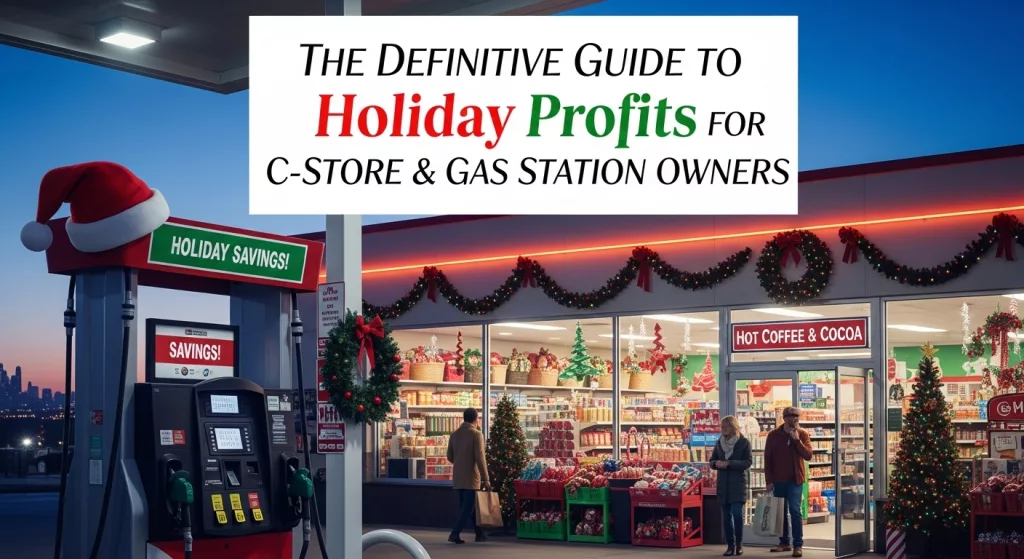Estimated reading time: 7 minutes
The holiday season-that crucial period from Thanksgiving through New Year’s-is more than just a typical retail bump; it’s a time of amplified opportunity for every gas station and convenience store owner. Your business benefits from a perfect storm of peak vehicle travel and cold weather demand, two forces that drive high-margin purchases inside the store. While NACS confirms that convenience stores sell an estimated 80% of the fuel purchased in the U.S., the real profit lift comes from mastering in-store sales. NRF data shows that core holiday spending continues to break records, with consumers budgeting around $902 per person for gifts, food, and other seasonal items. Here is exactly how to manage your products, promotions, and operations to convert seasonal demand into maximum revenue.
Industry Snapshot: Why Holidays are Different for C-Stores
The holiday season is essentially a massive, national surge in traffic for our channel.
The Fuel Funnel: While NACS data on fuel volume shows some month-to-month variation, the critical point is that the sheer number of vehicles stopping on key travel days (like the Wednesday before Thanksgiving or the Saturday before Christmas) spikes dramatically. These stops funnel thousands of potential customers to your door.
The Retail Lift: The NRF forecasts steady holiday sales growth, often between 2.5% and 3.5% over the previous year. For the c-store, this translates directly into a surge in impulse-driven categories like food and candy, which represents a significant portion of the seasonal budget for consumers, along with gift cards.
This massive influx of temporary, high-impulse customers means operational mistakes-like stockouts or slow service-are exponentially more costly.
Fuel Surges: Converting Traveler Traffic Into Sales
The key operational objective during travel peaks is monetizing the pump traffic. Every gallon sold must lead to an add-on sale inside the store.
Operational Staffing and Speed: The Wednesday before Thanksgiving is typically the most critical day for staffing. You gotta have every register open and ensure employees are trained to quickly manage transactions, because nothing frustrates a weary traveler more than a slow checkout. Train staff to upsell quickly at the register with specific, low-friction items like travel-size pain relievers (Tylenol/Advil), phone charging cables, or gum and mints.
Pump-Side Cross-Promotion: Use digital displays or pump toppers to execute the “Warm Up While You Fill Up” strategy. Market a clear incentive like “Get a Free Hot Coffee with any purchase over $5 inside” or “Bundle a salty snack and a packaged beverage for $4.99.” This immediately directs the low-margin fuel volume customer toward high-margin items inside. The Petrosoft POS system makes creating and tracking these multi-item bundle deals seamless, so you know exactly which promotions are driving the highest ROI.
The Cold-Weather Goldmine: Specialty Foodservice and Necessities
Once customers are inside, the cold weather offers two major, high-margin categories to exploit.
1. Hot Dispensed Beverages: Indulgence Drives Margin
Coffee is the backbone of c-store dispensed beverages, often maintaining one of the highest gross margins in foodservice.
Go All-In on Seasonal Flavors: You must introduce limited-time offer (LTO) flavors because customers expect indulgence. Stock specialty flavor syrups-Peppermint Bark Coffee, Gingerbread Cappuccino, or Cinnamon Roll Latte. NACS data shows that specialty coffee sales often see strong growth, which is exactly where these seasonal flavors live.
The Power Breakfast Bundle: The biggest lever for profit isn’t just selling coffee; it’s bundling it. Pair any size hot coffee with a high-margin bakery item like a fresh-baked muffin, croissant, or a pre-wrapped sausage biscuit for a slight discount. This strategy significantly boosts basket size and increases the profitability of every cup you sell.
2. Seasonal and Impulse Merchandise Stocking
During the holidays, consumers spend an average of $261 on seasonal items, food, and candy, per NRF data. C-stores need to capture that impulse spend.
Confectionery and Snack Displays: Seasonal candy drives major impulse sales. NACS data has shown that the holiday seasons account for 64% of total confectionery sales annually. Place specialty holiday items like Ferrero Rocher gift packs, Reese’s Peanut Butter Trees, or giant chocolate Santas on prominent endcap displays and at the checkout. Historically, packaged sweet snacks (snack cakes, muffins, donuts) show solid year-over-year gross profit growth (NACS).
Zero-Inventory Gifts (Gift Cards): This is a clean-margin opportunity. NRF consistently reports that Gift Cards are one of the most popular gift categories (purchased by about 44% of shoppers). Display popular cards like Visa/MasterCard (bank-issued), Starbucks, and Google Play prominently. Run a loyalty promotion like “Buy a $50 gift card, get a $5 bonus reward on fuel” to drive your own brand’s loyalty during the season.
3. Mission-Critical Winter Stockouts
These are necessary purchases for drivers in cold climates, with demand driven purely by environmental timing.
Dynamic Inventory for Freeze Events: For products like -20°F Windshield Washer Fluid, 50lb bags of Rock Salt, and emergency vehicle kits (jumper cables, flares), use your back-office system to track local weather alerts. Pre-order inventory but only surge the actual stocking level just before the first expected freeze or snow. Margins on these emergency items are significantly higher than standard merchandise.
Visibility is Profit: Place your highest-margin essentials-premium wiper blades and de-icer spray-right at the cash wrap or in a prominent display near the entryway.
Conclusion: Planning for a Profitable Peak
The holiday rush offers far more than just increased volume; it gives your convenience store a unique window to dramatically grow overall profitability. The foundation of this success is leveraging the data from your POS and back-office system to predict traffic surges, optimize cold-weather stocking, and execute smart cross-promotions. The owner who plans their merchandising, staffing, and promotions now is the one who will win the season.
The time to prepare for the holidays is not Thanksgiving. It’s now. Take action now: Audit your current seasonal inventory forecasts and ensure your teams are trained on every holiday upsell opportunity. The Petrosoft Smart Forecasting and Ordering system automatically analyzes last year’s holiday sales, weather patterns, and supplier lead times, giving you the precise quantities needed to meet demand without overstocking.
You cannot afford to let high traffic and high demand pass you by because of poor planning. Don’t leave margin on the table-contact Petrosoft today to see how our platforms can provide the real-time analytics needed to drive every holiday sale straight to your bottom line.
Frequently Asked Questions (FAQ) for Owner Operators
Which day is the most important to staff heavily for inside sales during the holidays?
The Wednesday before Thanksgiving is typically the most critical day for staffing. It combines the start of peak travel with a regular weekday commute. You’ll see high fuel volume and heavy morning coffee/snack sales as people hit the road. Maximize staff availability on this day to prevent long lines and missed impulse sales.
How do I handle inventory for seasonal items that don’t sell out by December 31st?
Plan for an aggressive markdown schedule starting the day after Christmas. Use your POS system to automatically drop prices on all holiday-specific merchandise (e.g., Reese’s Peanut Butter Trees, Santa candy) by 50% on December 26th, and move them immediately to a clearance endcap. It is always better to recoup 50% of the cost now than to hold the product for 11 months, tying up capital and taking up valuable space.
Is it profitable to offer a “Buy $X Gas, Get Free Coffee” promotion when fuel margins are low?
Yes, absolutely. Fuel sales may be low-margin, but they drive the high-margin coffee sale. The average gross margin on a cup of dispensed coffee often exceeds 60%. Offering a free cup of coffee costs you pennies in COGS but guarantees the customer enters the store, where the average basket size is likely to increase with impulse buys of snacks and gum. The increased total profit dollar from the in-store trip always outweighs the minimal cost of the free coffee.

Michael is a one of the industry experts that contribute to Petrosoft blog. Read more of his c-store and gas station insights click here


